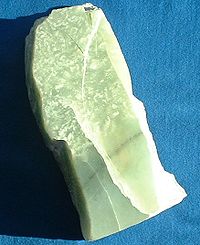
Photo from wikipedia
Poria cocos (Schw.) Wolf has been widely used in traditional Chinese medicine (TCM) for centuries. Its three medicinal parts are Poria Cutis, the epidermis or fulingpi in Chinese; White Poria,… Click to show full abstract
Poria cocos (Schw.) Wolf has been widely used in traditional Chinese medicine (TCM) for centuries. Its three medicinal parts are Poria Cutis, the epidermis or fulingpi in Chinese; White Poria, the middle part or baifuling; and Poria cum Radix Pini, the sclerotium with some part of host pine root or fushen. The hostwood in fushen is the inner part, known as fushenmu. The epidermis, middle part and middle-plus-inner part have different clinical applications, but the differences in their chemistry have not been well determined. Previous studies only concentrated on the differences in secondary metabolites in different parts of P. cocos; however, in this study, we focused on the carbohydrates, another major type of bioactive chemicals in P. cocos, which is also different from most of the other TCM researches. The carbohydrates (polysaccharides, oligosaccharides and monosaccharides) in three parts (epidermis, middle and inner part) of P. cocos were qualitatively and quantitatively characterized by high performance gel permeation chromatography coupled with charged aerosol detector (HPGPC-CAD) and ultra-performance liquid chromatography coupled with triple quadrupole mass spectrometry (UHPLC-QqQ-MS/MS). The obtained data were further processed by principal component analysis (PCA) and supervised orthogonal partial least squared discriminant analysis (OPLS-DA). The results showed that the epidermis contained more polysaccharides with larger molecular weight and higher amount of glucose residue than that of the middle and inner parts, indicating the epidermis as the key site of accumulation of P. cocos polysaccharides. When compared with the epidermis and inner part, the middle part contained the highest glucose molar ratio greater than 92 % in the three types of carbohydrates, whereas the inner part possessed the greatest molar ratio of mannose, xylose, arabinose, rhamnose, glucuronic acid, and galacturonic acid in all kinds of carbohydrates. Furthermore, PCA and OPLS-DA clearly demonstrated that arabinose, glucose, galacturonic acid, and ribose played key roles in the clusters between the epidermis, middle and inner parts. The observed differences in the chemical components in the three parts could provide some explanation for the discriminative clinical applications of Poria Cutis, White Poria, and Poria cum Radix Pini. These findings also provided a chemical basis for quality assessment of P. cocos.
Journal Title: Journal of pharmaceutical and biomedical analysis
Year Published: 2019
Link to full text (if available)
Share on Social Media: Sign Up to like & get
recommendations!